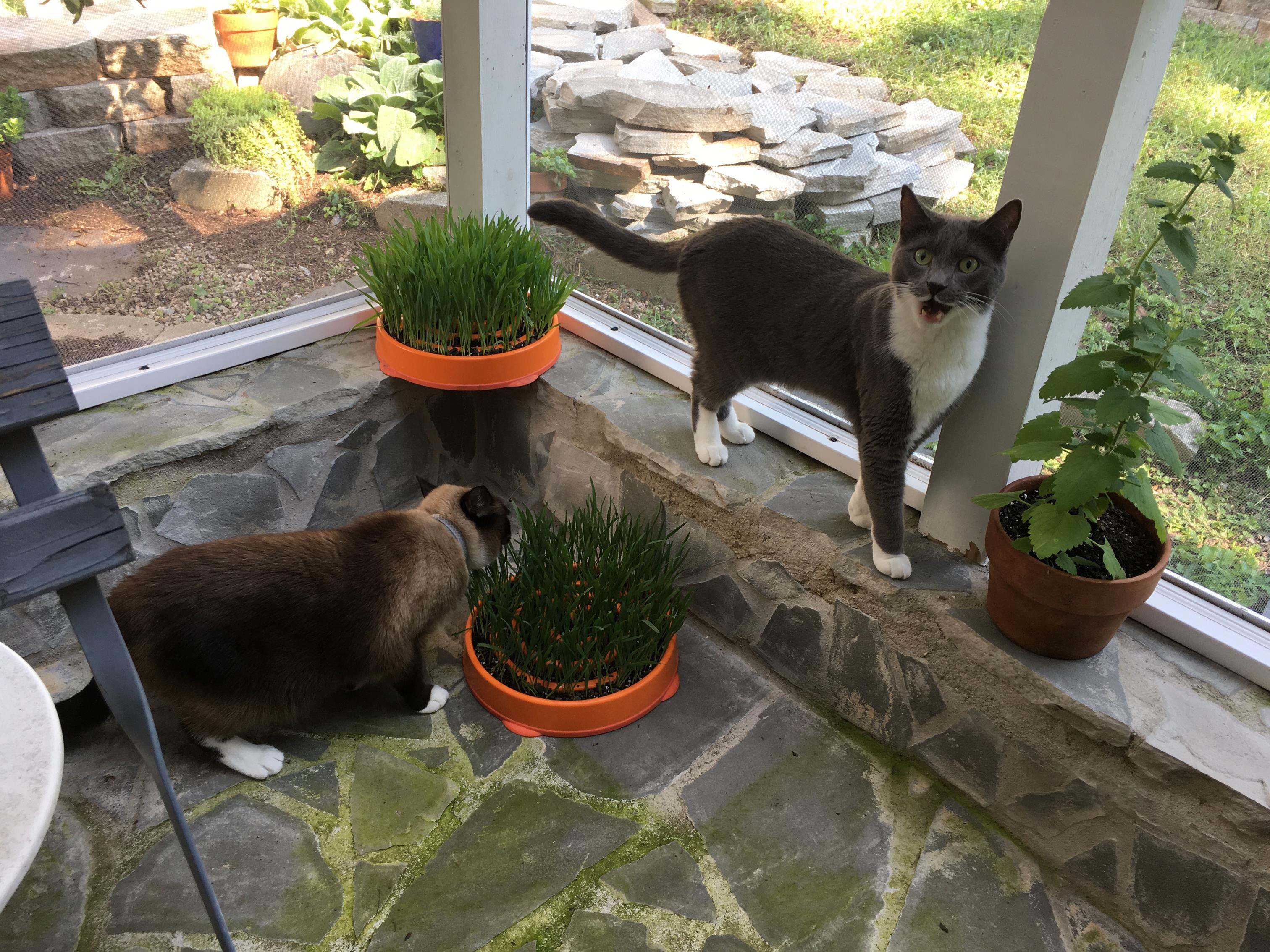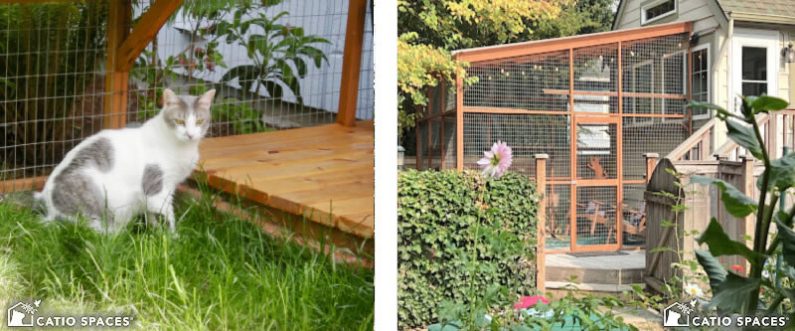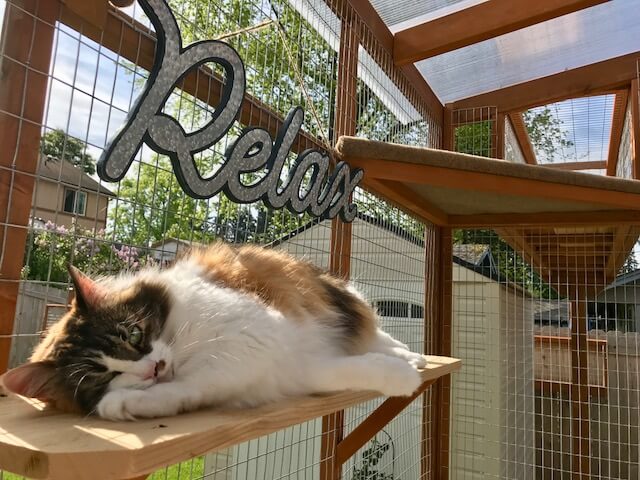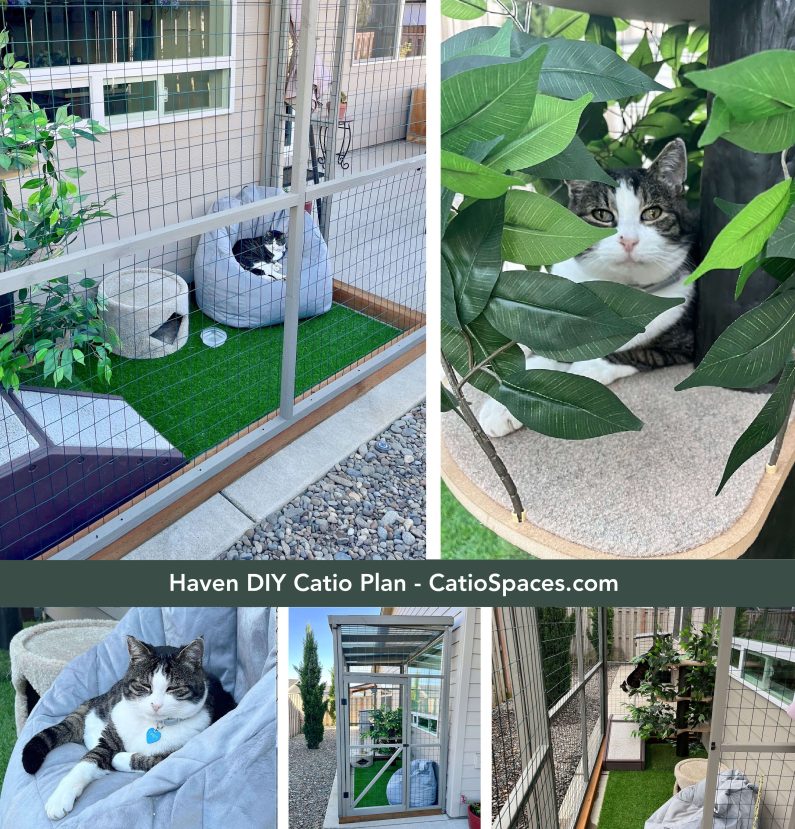Why build a catio?

Building a catio provides a safe and enriching outdoor space for your beloved cat. Cats are natural explorers and hunters, and allowing them access to the outdoors can greatly improve their overall well-being. However, letting cats roam freely outside can expose them to various dangers such as traffic accidents, predators, or ingestion of toxic plants.
By building a catio, you create a controlled environment where your furry friend can enjoy the benefits of being outdoors while remaining protected from harm. Catios offer numerous advantages for both cats and their owners.
Firstly, catios provide mental stimulation for indoor cats. The outdoor environment stimulates their senses, allowing them to experience new sights, sounds, and smells, which help alleviate boredom and reduce stress. Cats can also engage in natural behaviors like climbing, jumping, and bird-watching from the safety of their enclosure.
Secondly, catios promote physical exercise. Cats love to play and explore, and having an outdoor space allows them to stretch their legs and engage in activities that keep them active and fit. This can be particularly beneficial for overweight or elderly cats who may not have the freedom or ability to explore the outdoors on their own.
Lastly, catios provide peace of mind for cat owners. By providing a secure space for your cat to enjoy the outdoors without risk of injury or escape, you can eliminate worries about them getting lost or encountering dangerous situations.
In summary, building a catio is a fantastic way to enhance your cat's quality of life by providing them with a safe outdoor haven. It offers mental stimulation, physical exercise, and peace of mind for both you and your feline companion.
Planning your catio

When it comes to building a catio, proper planning is essential. Before diving into the construction process, consider the following factors to ensure a well-designed and functional outdoor haven for your cat.
Firstly, assess the available space in your yard or balcony. Measure the area where you plan to build the catio, taking into account any existing structures or obstacles that may affect its layout. Consider the size of your cat(s) and their activity preferences when determining the dimensions of the enclosure.
Next, think about the style and design of your catio. Consider whether you want an attached or freestanding structure, and whether you prefer a simple or elaborate design. Take inspiration from existing catios or consult with professionals who specialize in designing cat enclosures for guidance.
Additionally, consider incorporating features that will cater to your cat's specific needs and interests. This could include platforms for climbing, perches for lounging, scratching posts, hiding spots, and interactive toys. Providing a variety of stimulating elements will keep your cat entertained and engaged while outdoors.
Moreover, take into account the climate in your area. Ensure that your catio provides adequate shade and protection from harsh weather conditions such as excessive heat or cold temperatures. Consider adding insulation or removable panels to make it suitable for year-round use.
Lastly, check local regulations and obtain any necessary permits before building your catio. Some neighborhoods or homeowner associations may have restrictions on outdoor structures or fencing heights.
By carefully planning out these details, you can create a catio that meets both your cat's needs and your aesthetic preferences. Proper planning will ensure a safe, enjoyable outdoor space where your feline friend can relax and explore to their heart's content.
Choosing the right location

When it comes to building a catio, choosing the right location is crucial. The ideal spot should offer a safe and comfortable environment for your cat to enjoy the outdoors.
Firstly, consider the accessibility of the location. It should be easily accessible from your home, allowing your cat to enter and exit freely. You may want to choose an area that is close to a window or a door so that your cat can easily transition between indoor and outdoor spaces.
Next, evaluate the surroundings of the location. Make sure there are no potential hazards nearby such as busy roads, toxic plants, or areas frequented by predators. Keep in mind that cats are curious creatures, so it's important to provide them with a secure and supervised environment.
In addition, consider the amount of sunlight and shade available in the chosen location. Cats love basking in the sun but also need a shaded area where they can cool down. Look for a balance between sunlight and shade throughout different times of the day.
Furthermore, think about the privacy of the location. Cats appreciate having their own space where they feel safe and undisturbed. Consider placing the catio in a quiet corner of your yard or creating privacy barriers using hedges, fences, or trellises.
Lastly, take into account any local regulations or restrictions on outdoor structures. Check with your homeowner association or local authorities to ensure compliance with any rules regarding fencing heights or permits required for construction.
By carefully selecting the right location for your catio, you can provide your cat with a secure and enjoyable outdoor haven that meets both their needs and yours.
Designing your catio

When it comes to designing your catio, there are a few key factors to consider. First and foremost, you want to create a space that is both safe and stimulating for your cat.
Start by determining the size of your catio based on the available space and the number of cats you have. Cats love vertical space, so incorporating different levels or shelves can make the catio more interesting for them. Adding platforms or ramps can also provide exercise opportunities and help simulate a natural outdoor environment.
Consider the layout and flow of your catio. Think about where you will place things like scratching posts, climbing structures, and resting spots. This will not only keep your cat entertained but also ensure they have areas to scratch, nap, and perch.
Next, think about the materials you will use for your catio. Opt for materials that are sturdy, weather-resistant, and easy to clean. Make sure any openings or mesh used are escape-proof and securely attached.
Don't forget to include some elements that add visual appeal to your catio. Consider adding plants or herbs that are safe for cats to sniff and nibble on. You can also incorporate decorative elements like hanging toys or bird feeders outside the catio to provide entertainment for your cat.
Lastly, remember to design your catio with easy access for cleaning purposes. Choose materials that can be easily wiped down or hosed off when needed.
By carefully considering these factors while designing your catio, you can create a safe and enjoyable outdoor haven for your cat that they will love spending time in.
Materials and tools needed

To build your catio, you will need a few essential materials and tools. These will ensure that your outdoor haven for your cat is sturdy, safe, and secure.
Firstly, consider the materials for the structure of your catio. You will need strong and durable materials such as wood or PVC pipes to create the framework. Plywood or wire mesh can be used to enclose the sides and top of the catio, providing ventilation while keeping your cat contained. Opt for weather-resistant materials to ensure longevity.
In addition to the basic structure, there are several other materials you may need. These include screws or nails to assemble the frame, brackets or clips to secure the panels together, and hinges for any doors or windows you may incorporate. Make sure these fasteners are rust-resistant to withstand outdoor conditions.
You may also want to consider adding additional features to enhance your cat's experience in the catio. This could include ramps or shelving made from sturdy boards or carpeting for climbing opportunities. Consider adding a scratching post or a cozy resting spot such as a box with blankets or pillows.
When it comes to tools, a basic toolkit should suffice. This may include a drill with various bits, a saw for cutting materials to size, measuring tape for accurate measurements, and a level to ensure everything is straight and balanced. Don't forget safety equipment such as goggles and gloves when using power tools.
By gathering these materials and tools before starting your catio project, you can ensure a smooth construction process and create a safe outdoor haven that your cat will love exploring.
Building your catio

Building your catio involves putting together the framework and enclosing it with the necessary materials. Begin by assembling the base and sides of the structure using wood or PVC pipes. Use screws or nails to securely attach the pieces together, ensuring stability.
Once the basic frame is constructed, you can start adding the side panels and roof. Plywood or wire mesh are common choices for these enclosures. Secure them to the frame using brackets or clips, making sure they fit tightly to prevent any gaps that may allow your cat to escape.
If you plan on incorporating doors or windows in your catio, make sure to install hinges so that they can be easily opened and closed.
When building your catio, it's important to keep safety in mind. Make sure all edges are smooth and free of sharp points that could harm your cat. Also, ensure that there are no gaps between panels where your cat could get stuck.
Throughout the construction process, use a level to ensure that everything is straight and balanced. This will help create a sturdy structure that will withstand outdoor conditions.
Remember to follow any local building codes or regulations when constructing your catio. Some areas may require permits or have specific guidelines regarding outdoor enclosures for pets.
By following these steps and paying attention to detail, you can successfully build a secure and comfortable catio where your cat can safely enjoy the outdoors while being protected from potential dangers.
Adding essentials for your cat

When designing your catio, it's important to consider the needs and comforts of your cat. Adding essential features will make their outdoor haven even more enjoyable. Here are some key elements to incorporate into your catio:
- Climbing structures: Cats love to climb and explore their surroundings. Install shelves, ramps, or vertical scratching posts to provide opportunities for climbing and perching.
- Resting spots: Create cozy and comfortable areas where your cat can relax and nap. Include soft beds, blankets, or hammocks for them to curl up in.
- Litter box: Make sure to allocate space for a litter box within the catio. This will encourage your cat to use it rather than finding alternative spots in the enclosure.
- Water and food stations: Provide fresh water and a feeding area within the catio. Consider placing water fountains to keep the water circulating and appealing to your cat.
- Scratching surfaces: Cats have a natural instinct to scratch, so include vertical or horizontal scratching posts made of sisal rope or corrugated cardboard to satisfy this behavior.
- Toys and interactive elements: Keep your cat mentally stimulated by adding toys such as feather wands, puzzle feeders, or balls for them to chase and play with.
- Shaded areas: Ensure that there are shaded spots within the catio where your cat can retreat from direct sunlight on hot days.
Remember to regularly inspect these additions for any signs of wear or damage that may need repair or replacement. By providing these essentials, you'll create a stimulating and comfortable environment where your cat can safely enjoy their time outdoors in the catio.
Maintaining and cleaning your catio

Maintaining and cleaning your catio is essential to ensure a safe and enjoyable environment for your cat. Regular maintenance will help keep the catio clean, prevent the accumulation of dirt and debris, and minimize the risk of pests or bacteria. Here are some tips for maintaining and cleaning your catio:
- Regular inspections: Conduct regular inspections of the catio to check for any signs of damage, wear, or loose structures. Repair or replace any damaged parts promptly to maintain the integrity of the enclosure.
- Cleaning schedule: Establish a cleaning schedule to keep your catio tidy. This can include sweeping away leaves or debris, wiping down surfaces with pet-safe cleaners, and disinfecting litter box areas regularly.
- Litter box maintenance: Clean and change the litter box frequently to prevent odors and maintain cleanliness in the catio. Use cat-friendly litter that is easy to scoop and dispose of properly.
- Pest control: Take steps to prevent pests from entering the catio by sealing any gaps or openings and using natural deterrents like citronella plants or pet-safe pest control products.
- Odor management: Use odor-neutralizing sprays or natural remedies like baking soda to control any unpleasant smells in the catio.
- Toy rotation: Rotate your cat's toys regularly to keep them engaged and prevent boredom. Wash plush toys periodically to remove dirt or bacteria.
Remember that maintaining and cleaning your catio is an ongoing process. Stay vigilant, adapt your routine as needed, and prioritize your cat's comfort and safety by ensuring a clean and well-maintained outdoor haven for them to enjoy.
Enjoying your cat's outdoor haven

Once you have successfully built and maintained your catio, it's time to see your cat truly enjoy their outdoor haven. Watching your furry friend explore, play, and relax in their safe outdoor space is a rewarding experience.
Give your cat plenty of opportunities to engage with their surroundings. Set up different levels or platforms where they can perch, climb, and observe the world around them. Installing shelving or ramps can also provide added vertical space for your cat to explore.
Consider adding a cozy spot for your cat to rest. Place a comfortable bed or cushioned area inside the catio where they can curl up and take a nap. Providing shade options such as umbrellas or shaded areas will ensure that your cat can enjoy the outdoors even on hot days.
To enhance their sensory experience, incorporate plants into the catio. Choose non-toxic plants such as catnip or cat grass that are safe for feline consumption. These plants can stimulate their senses and provide entertainment.
Don't forget to spend quality time with your furry companion in the catio. Engage in interactive play sessions using toys like feather wands or laser pointers. This will help keep them active, mentally stimulated, and strengthen the bond between you and your pet.
Lastly, take time to simply observe and appreciate your cat's enjoyment in their outdoor haven. Watch as they chase butterflies, bask in the sunlight, or just soak in the fresh air. Seeing them happy and content in their carefully designed space will bring you joy knowing that you have provided them with a safe and enriching environment.
Enjoying your cat's outdoor haven is about creating moments of relaxation, exploration, and bonding that will bring both you and your feline companion immeasurable happiness.




0 Comments